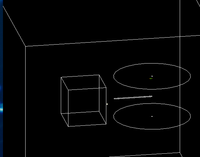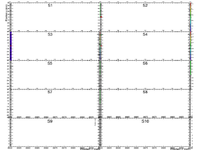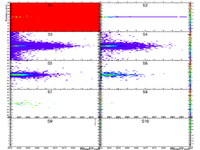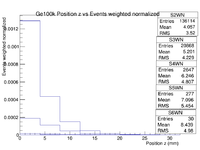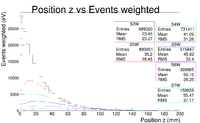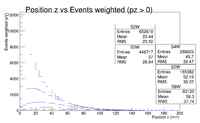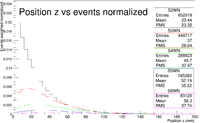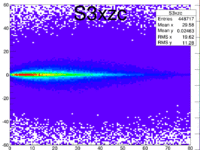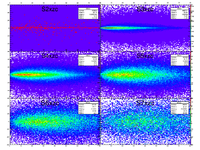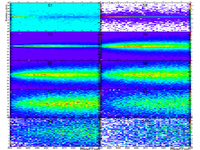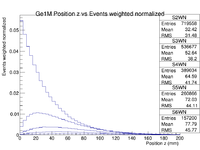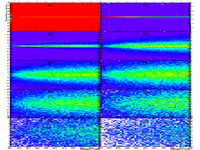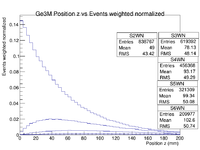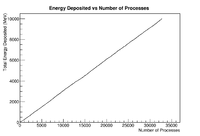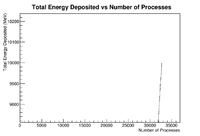Difference between revisions of "CodyMilne G4Proj"
| Line 23: | Line 23: | ||
[[File:CM_Detectorsetup.png | 200 px]] | [[File:CM_Detectorsetup.png | 200 px]] | ||
| + | |||
| + | Photons are fired from a cylindrical gps from within the inner radius of the lead cask. This cylinder has a height of 40.25 cm and a radius of 0.5 cm. The goal of this gun is to simulate decay from a fuel rod on the inside of the lead cylinder. Angular cuts are made on the gun to limit wasteful gammas from being calculated. There is a phi (x direction) cut of 22 degrees, centered on the hole leading to the Germanium block, and a theta cut of about 45 degrees. The phi coincides with the 1mm side of the hole, and the theta coincides with the 1cm side of the hole. | ||
=Results of energy loss in Germanium= | =Results of energy loss in Germanium= | ||
Revision as of 19:19, 28 May 2016
Photon Energy deposition in a pure Ge crystal
Here is the mass attenuation cross sections for Germanium ------ 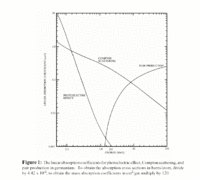
Here is the total photon attenuation for Germanium ------------- 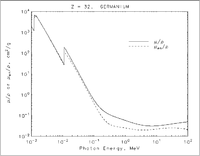
Here is the range of electrons in Ge as a function of energy --- 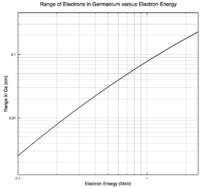
Perform a fit to the 2nd hit distribution using an exponential fitting function. Do this for 100keV, 500keV, 1MeV, 3Mev and for this test, please run some 10 MeV gammas. —the result of the fit should be equal to the mass attenuation coefficient multiplied by the density of Ge. Therefore, dividing the fit result by 5.323 yields the mass attenuation coefficient at each energy and we can compare them directly with the NIST database values for validation of the GEANT4 total cross sections and sampling.
Using S2WN.Fit("expo");
I got for 3MeV constant: -1.88934 and slope: -1.84926e-02 +/- 1.63709e-02. Research shows this says these values are on a "log scale", not sure how exactly to read this.
1MeV: -2.852121 slope: -3.04127e-02 +/- 4.63910e-02
500k: -3.66350 slope: -4.25739e-02 +/- 1.10890e-01
3) for the same events (2nd hits), make a plot of the number of times that interaction was photoelectric, compton or pair production. Make the same 3-bin plot for each of the incident gamma energies. The relative rates of the first interactions evolve as a function of incident photon energy (see the plot of linear absorption coefficient on the wiki). —The ratios of event types can be compared with published values. I think these "spot checks" at those five energies are all we need to complete our initial validation of the GEANT4 sub-sampling.
Simulation Set Up - Detector Construction
A pure block of 50x50x50cm Germanium is placed in front of a lead cylinder, inner radius 0.75cm, outer radius 50cm of height 55cm. There is a 1mmx1cm hole (made of Argon) from the center of the lead cask to the outside, pointed toward the middle of the Germanium crystal.
Photons are fired from a cylindrical gps from within the inner radius of the lead cask. This cylinder has a height of 40.25 cm and a radius of 0.5 cm. The goal of this gun is to simulate decay from a fuel rod on the inside of the lead cylinder. Angular cuts are made on the gun to limit wasteful gammas from being calculated. There is a phi (x direction) cut of 22 degrees, centered on the hole leading to the Germanium block, and a theta cut of about 45 degrees. The phi coincides with the 1mm side of the hole, and the theta coincides with the 1cm side of the hole.
Results of energy loss in Germanium
10 eV
1-D plot of events for each step as function of Z
1-D plot of the energy deposited for each step as function of Z
100 eV
Start with = 100 eV
1 keV
Start with = 1 keV
10 keV
Start with = 10 keV
Energy Deposition
Send photons from inside an infinite crystal at 100, 500, 1000,3000 keV energy. Add up all the energy loss and see if you get delta functions or a delta + tail because GEANT4 stopped taking the photon and thus the energy is not accounted for.
100 keV
Start with = 100 keV
Initial verification - first hit position distribution is consistent with published attenuation coefficient.
500 keV
Start with = 500 keV
Change units on Y-axis to Energy (eV?)
"No Backscattering" Do another plot with momentum cut Pz>0
Add 9000 to Z-position to start Ge barrier at zero
Initial verification - The first gamma interaction distribution is consistent with the published Ge mass attenuation coefficient at 500keV (0.08212) and a Ge density of 5.323.
Are the 2-D plots energy weights (normalized)? Set the Z-axis color range by hand in cold.
1 MeV
Start with = 1 MeV
Initial verification - first interaction is consistent with published attenuation coefficient.
3 MeV
Start with = 3 MeV
Initial verification - first interaction distribution is consistent with published attenuation coefficient.
10 MeV
This is looking at total energy deposition from the child particles in Germanium, from a incident gamma shot from within the crystal.
Runing Types
nohup ../exampleN02 run1.mac > /dev/null &
Divide canvas into 2 x 5
